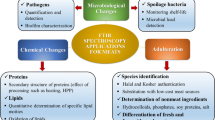Abstract
Advances in spectroscopy now enable researchers to obtain information about chemical and physical components in food or biological materials at the molecular level. Various spectroscopic techniques (e.g., atomic absorption spectroscopy, Raman and Fourier-transform infrared spectroscopy, near infrared spectroscopy, nuclear magnetic resonance spectroscopy, mass spectroscopy, X-ray fluorescence spectroscopy, ultra-violet spectroscopy) have been used to study structure-function relationships in foods (both liquid and solid) to improve overall food quality, safety and sensory characteristics; to investigate fungal infections in plant materials (e.g., fruits, seeds); or to study mobility of different chemical components in food materials. Processing, analyzing, and displaying these data can often be difficult, time-consuming, and problem-specific. Chemometrics is well established for calibrating the spectral data to predict concentrations of constituents of interest. Similarly, proteomics deals with the structure-function relationship of proteins. Since most of the food processing industries are becoming increasingly automated, there is a need to understand how the spectroscopic data can be used for automation. In this paper, we have provided basic working principles of the above mentioned spectroscopic techniques, examples of the use of spectral data in food processing, methods of analysis of spectral data and their integration in the automation process.



Similar content being viewed by others
References
G.R. Harrison, J. Food Sci. 3, 121 (1938). doi:10.1111/j.1365-2621.1938.tb17043.x
T. Woodcock, G. Downey, C.P. O’Donnell, J. Near Infrared Spec. 16, 1 (2008)
W. Slavin, Appl. Spectrosc. 20, 281 (1966). doi:10.1366/000370266774385787
B.G. Osborne, in Encyclopedia of Analytical Chemistry, ed. by R.A. Meyers (Wiley, New York, NY, 2000), p. 1
W. Wang, J. Paliwal, Sens. Instr. Food Qual. 1, 193 (2007). doi:10.1007/s11694-007-9022-0
S.C.C. Wiedemann, W.G. Hansen, M. Snieder, V.A.L. Wortel, Analusis Mag. 26, M38 (1998). doi:10.1051/analusis:199826040038
R.L. Wehling, in Food Analysis, ed. by S.S. Nielsen (Springer, New York, NY, 2003), p. 387
J.J. Workman, Appl. Spectrosc. Rev. 31, 251 (1996). doi:10.1080/05704929608000571
R.H. Wilson, H.S. Tapp, Trends Anal. Chem. 18, 85 (1999). doi:10.1016/S0165-9936(98)00107-1
E.C.Y. Li-Chan, Trends Food Sci. Technol. 7, 361 (1996). doi:10.1016/S0924-2244(96)10037-6
Y. Ozaki, in Spectral Methods in Food Analysis, ed. by M.M. Mossoba (Marcel Dekker, Inc., New York, NY, 1999), p. 427
G.W. Schrader, J.B. Litchfield, S.J. Schimdt, Food Technol. Dec., 77 (1992)
S.J. Schmidt, X. Sun, J.B. Litchfield, Crit. Rev. Food Sci. Nutr. 36, 357 (1996)
M.H. Penner, in Food Analysis, ed. by S.S. Nielsen (Springer, New York, NY, 2003), p. 371
G.M. Strasburg, R.D. Ludescher, Trends Food Sci. Technol. 6, 69 (1995). doi:10.1016/S0924-2244(00)88966-9
J. Christensen, A.M. Ladefoged, L. Nørgaard, J. Inst. Brewing 111, 3 (2005)
E. Sikorska, I.V. Khemelinskii, M. Sikorski, F. Caponio, M.T. Bilancia, A. Pasqualone, T. Gomes, Int. J. Food Sci. Technol. 43, 52 (2008)
M. Carbonaro, Trends Food Sci. Technol. 15, 209 (2004)
J.S. Smith, R.A. Thakur, in Food Analysis, ed. by S.S. Nielsen (Springer, New York, NY, 2003), p. 423
A. De Leonardis, V. Macciola, M. De Felice, Int. J. Food Sci. Technol. 35, 371 (2000). doi:10.1046/j.1365-2621.2000.00389.x
A. Celedόn, J.M. Aguilera, Food Sci. Technol. Int. 8, 101 (2002). doi:10.1177/1082013202008002208
S. Keller, T. LiJchte, B. Dippel, B. Schrader, Fresenius J. Anal. Chem. 346, 863 (1993). doi:10.1007/BF00321306
P. Chen, M.J. McCarthy, R. Kauten, Trans. ASAE 32, 1747 (1989)
M.J. McCarthy, R.J. Kauten, Trends Food Sci. Technol. Dec., 134 (1990)
C. Simoneau, M.J. McCarthy, J.B. German, Food Res. Int. 26, 387 (1993). doi:10.1016/0963-9969(93)90082-T
M.J. McCarthy, K.L. McCarthy, J. Sci. Food Agric. 65, 257 (1994). doi:10.1002/jsfa.2740650302
B. Hills, Trends Food Sci. Technol. 6, 111 (1995). doi:10.1016/S0924-2244(00)88993-1
R.R. Ruan, P.L. Chen, Water in Foods and Biological Materials: A Nuclear Magnetic Resonance Approach (Technomic Publishing, Lancaster, PA, 1998)
S. Divakar, J. Food Sci. Technol. 53, 469 (1998)
T.M. Eads, in Spectral Methods in Food Analysis, ed. by M.M. Mossoba (Marcel Dekker, Inc., New York, NY, 1999), p. 1
I.J. Colquhoun, B.J. Goodfellow, in Spectroscopic Techniques for Food Analysis, ed. by R.H. Wilson (VCH Publishers, Inc., New York, NY, 1999), p. 87
J.A.G. Roach, in Spectral Methods in Food Analysis, ed. by M.M. Mossoba (Marcel Dekker, Inc., New York, NY, 1999), p. 159
S.M. Musser, in Spectral Methods in Food Analysis, ed. by M.M. Mossoba (Marcel Dekker, Inc., New York, NY, 1999), p. 251
F.A. Mellon, in Spectroscopic Techniques for Food Analysis, ed. by R.H. Wilson (VCH Publishers, Inc., New York, NY, 1999), p. 181
G. Downey, Research Report No. 14 (The National Food Centre, Dublin, 1999)
H. Huang, H. Yu, H. Xu, Y. Ying, J. Food Eng. 87, 303 (2008)
G. Downey, Trends Anal. Chem. 17, 418 (1998). doi:10.1016/S0165-9936(98)00042-9
J. Sádecká, J. Tóthová, J. Czech, Food Sci. 25, 159 (2007)
W.J. Hurst, in Spectroscopic Techniques for Food Analysis, ed. by R.H. Wilson (VCH Publishers, Inc., New York, NY, 1999), p. 221
J. Chen, X.Z. Wang, J. Chem. Inf. Comput. Sci. 41, 992 (2001). doi:10.1021/ci0004053
W.F. McClure, in Spectroscopic Techniques for Food Analysis, ed. by R.H. Wilson (VCH Publishers, Inc., New York, NY, 1999), p. 13
Acknowledgement
Authors thank the Canada Research Chairs Program for partial funding of this study.
Author information
Authors and Affiliations
Corresponding author
Additional information
Meeting presentation: Food Processing Automation Conference, Providence, RI, 28–29 June 2008. ASABE Publication Number 701P0508 cd.
Rights and permissions
About this article
Cite this article
Ghosh, P.K., Jayas, D.S. Use of spectroscopic data for automation in food processing industry. Sens. & Instrumen. Food Qual. 3, 3–11 (2009). https://doi.org/10.1007/s11694-008-9068-7
Received:
Accepted:
Published:
Issue Date:
DOI: https://doi.org/10.1007/s11694-008-9068-7




